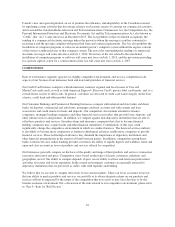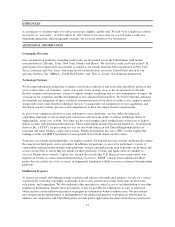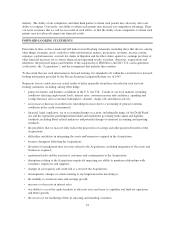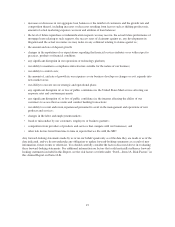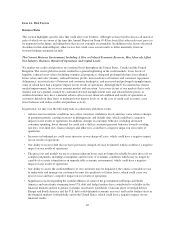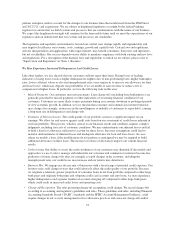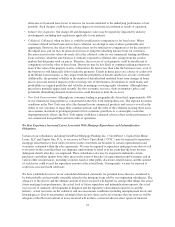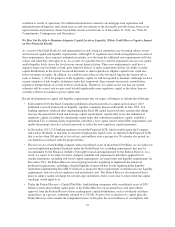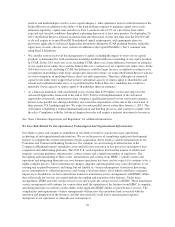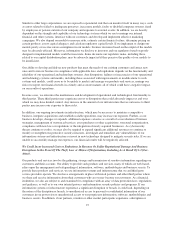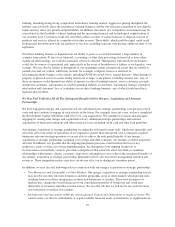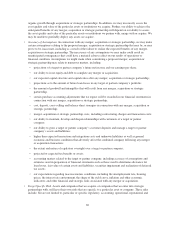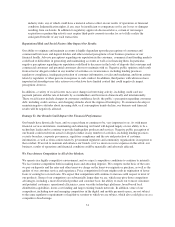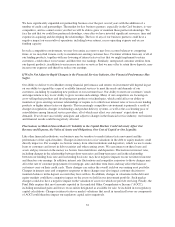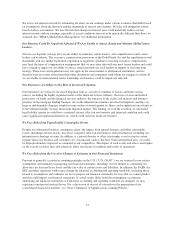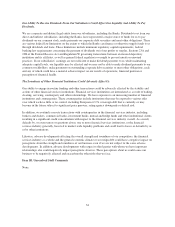Capital One 2013 Annual Report Download - page 45
Download and view the complete annual report
Please find page 45 of the 2013 Capital One annual report below. You can navigate through the pages in the report by either clicking on the pages listed below, or by using the keyword search tool below to find specific information within the annual report.condition or results of operations. For additional information related to our mortgage loan repurchase and
indemnification obligations and related reserves and our estimate of the reasonably possible future losses from
representation and warranty claims beyond the current accrual levels as of December 31, 2013, see “Note 20-
Commitments, Contingencies and Guarantees.”
We May Not Be Able to Maintain Adequate Capital Levels or Liquidity, Which Could Have a Negative Impact
on Our Financial Results.
As a result of the Dodd-Frank Act and international accords, financial institutions are becoming subject to new
and increased capital and liquidity requirements. Although U.S. regulators have finalized regulations for some of
these requirements, there remains continued uncertainty as to the form the additional new requirements will take
or how and when they will apply to us. As a result, it is possible that we could be required to increase our capital
and/or liquidity levels above the levels in our current financial plans. These new requirements could have a
negative impact on our ability to lend, grow deposit balances or make acquisitions and on our ability to make
capital distributions in the form of increased dividends or share repurchases. Higher capital levels could also
lower our return on equity. In addition, we could become subject to the Advanced Approaches framework as
early as January 1, 2016 for purposes of the regulatory capital we will be required to maintain. Although we have
current estimates of risk weight calculations under that framework, there remains uncertainty around future
regulatory interpretations of certain of those calculations. Therefore, we cannot assure you that our current
estimates will be correct and we may need to hold significantly more regulatory capital in the future than we
currently estimate to maintain a given capital ratio.
Recent developments in capital and liquidity requirements that we expect will impact us include the following:
• In December 2010, the Basel Committee published a final framework on capital and in January 2013
published a revised framework on liquidity, together commonly known as Basel III. In July 2013, U.S.
banking regulators finalized rules implementing the Basel III capital framework that, among other things:
increase the general risk-based and leverage capital requirements; significantly revise the definition of
regulatory capital, including by eliminating certain items that constituted regulatory capital; establish a
minimum Tier 1 common equity requirement; introduce a new capital conservation buffer requirement; and
update the prompt corrective action framework to reflect the new regulatory capital minimums.
• In November 2013, U.S banking regulators issued the Proposed LCR, which would require the Company
and each of the Banks to maintain an amount of high quality liquid assets (as defined in the Proposed LCR)
that is no less than 100 percent of its total net cash outflows over a prospective 30-calendar day period (as
calculated in accordance with the proposed rule).
• Because we are a bank holding company with consolidated assets of more than $50 billion, we are subject to
certain heightened prudential standards under the Dodd-Frank Act, including requirements that may be
recommended by the Financial Stability Oversight Council and implemented by the Federal Reserve. As a
result, we expect to be subject to more stringent standards and requirements than those applicable for
smaller institutions, including risk-based capital requirements, leverage limits and liquidity requirements. In
December 2011, the Federal Reserve released proposed rules beginning to implement the enhanced
prudential requirements, including a detailed liquidity framework that would supplement the liquidity
regulations implementing Basel III. If finalized as proposed, these requirements would increase our liquidity
requirements and associated compliance and operational costs. The Federal Reserve also indicated that it
plans to adopt a capital surcharge for certain larger institutions, but it is not clear to what extent the capital
surcharge would apply to us.
• Under the Federal Reserve’s Capital Plan Rule, bank holding companies with consolidated assets of $50
billion or more must submit capital plans to the Federal Reserve on an annual basis and must obtain
approval from the Federal Reserve before making most capital distributions, such as dividends and share
repurchases, in a process commonly referred to as CCAR. As part of its evaluation of a capital plan, the
Federal Reserve will consider the comprehensiveness of the plan, the reasonableness of assumptions and
25



